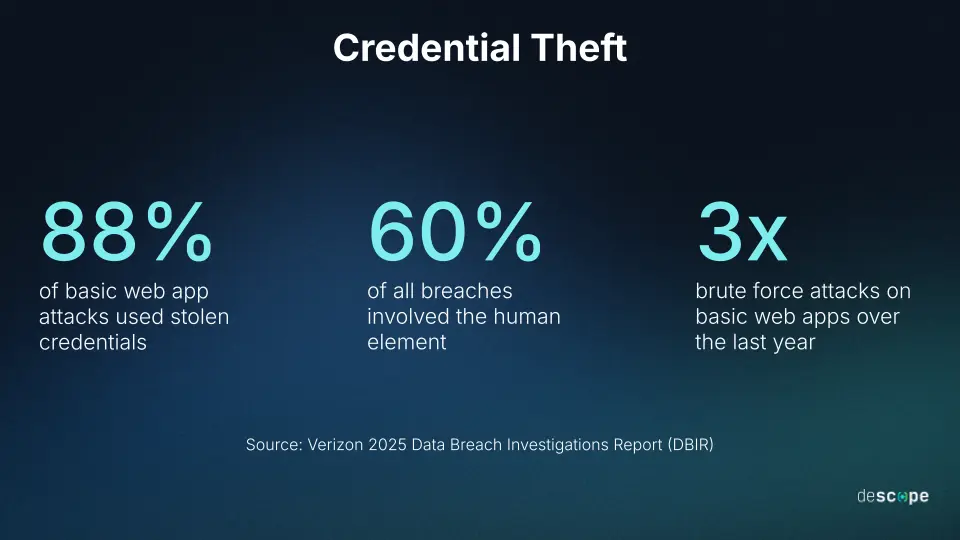In June 2025, the digital world faced a chilling wake-up call: nearly 16 billion usernames and passwords were leaked in one of the largest cybersecurity breaches in history. The sheer scale of the leak proved what many experts have warned for years: our reliance on traditional, password-based systems is no longer just outdated, it’s dangerous.
This password breach didn’t just compromise personal emails and bank accounts. It exposed the fragile foundation on which most of our digital lives are built. From government portals to corporate servers and everyday apps, passwords, often reused, weak, or stolen, remain the weakest link.
As panic turns to action, the spotlight is shifting toward blockchain digital identity: a decentralized, user-controlled model that promises both privacy and security. But can it truly replace the password? And more importantly, is it ready for mass adoption?
Why Passwords Are Broken
As a recent report shows, “Credentials remain the number‑one battleground in cybersecurity,” a reminder that until we replace them, passwords will remain prime targets.

Centralized storage = Single point of failure
Most organizations store user credentials in centralized databases. This structure creates a high-value target; if one vault is compromised, it exposes access to potentially millions of users.
The June 2025 password breach, which leaked nearly 16 billion credentials, shows this vulnerability. No matter how well a system is defended, a centralized model is a target because it offers hackers a single door to a large amount of data.
Reuse, phishing, and social engineering
According to multiple password hygiene reports in 2025, around 94% of users still reuse passwords across multiple sites. This means a single breached password, say, from a social media platform, can compromise banking, email, or cloud accounts too.
On top of this, phishing attacks have grown more advanced, often using AI-generated emails or fake login pages. Combined with classic social engineering tricks (like posing as IT support), hackers can obtain login credentials even without technical skills.
Weak vs. Strong passwords: most users don’t comply
Even when password managers and security teams recommend using strong, complex passwords, many users fall back on simple, memorable ones, like “123456” or a pet’s name. These are easily guessed or cracked using brute-force attacks.
Verizon’s 2025 Data Breach Investigations Report (DBIR) confirmed that credentials remain the top attack vector, with password misuse contributing to over 60% of initial breaches. Worse still, many users avoid using multi-factor authentication, leaving them more exposed.
The economics of breaches: selling logins on the dark web
Stolen credentials aren’t just exploited by individual hackers; they’re bought and sold in bulk on dark web marketplaces. A single login can sell for anywhere between $2 and $20, depending on the service (banking and enterprise logins go for even more).
Cybercriminals package thousands of credentials into “combo lists” for use in automated attacks like credential stuffing. This turns password leakages into a full-blown criminal economy that continuously rewards bad actors.
The Promise of Blockchain-Based Digital Identity
As traditional password systems continue to fail at scale, blockchain digital identity offers a fundamentally different approach, one that puts users in full control of their credentials while reducing the risks of centralized data breaches.
Self-Sovereign Identity (SSI)
Before you dive into the future of digital identity, you need to understand what self-sovereign identity is. Self-Sovereign Identity is a model where individuals, not platforms or governments, own and manage their digital credentials. With SSI, you no longer need to trust a third-party server to store your login details. Your identity data lives in your digital wallet, not on someone else’s database.
This eliminates the single point of failure seen in centralized systems and allows users to authenticate themselves directly without needing to “log in” through traditional means. Control shifts back to the individual.
Decentralized Identifiers (DIDs)
DIDs are a new type of globally unique identifier built specifically for decentralized networks. Unlike traditional usernames or email-based logins, DIDs are cryptographically verifiable and do not rely on a central issuing authority.
When a user logs into a service using a DID, they prove their identity using digital signatures, without revealing personal details like email or phone number. This offers greater privacy, reduces data leaks, and makes phishing attacks much harder to pull off.
Verifiable Credentials (VCs)
Verifiable credentials are digital attestations, like diplomas, ID cards, or certificates, issued by trusted entities (e.g., governments, universities, banks) and stored in a user’s wallet. These credentials can be selectively disclosed, meaning a user can prove they’re over 18 or have a valid license without revealing their full identity or the document itself.
The use of advanced cryptographic techniques like zero-knowledge proofs allows users to share only what’s necessary, creating safer, more privacy-preserving authentication flows.
RELATED: Zero-Knowledge Everything: Trust, Privacy, and Verification in the Digital Age
How Blockchain ID Works in Practice
Using blockchain for identity systems offers a streamlined and secure alternative to traditional logins. Here’s a simple breakdown of how the process typically works —from identity creation to seamless authentication —without ever needing a password.
Step 1: User creates a DID and stores it in a digital wallet
The journey begins when a user creates a Decentralized Identifier (DID) through a digital identity app or wallet, such as SpruceID, Iden3, or Dock.
This DID is a unique, cryptographically secure ID linked to the user’s private key. It doesn’t rely on an email or username and isn’t issued by a central server. The DID is securely stored in the user’s digital wallet on their device.
Step 2: Institutions issue verifiable credentials to the wallet
Next, trusted institutions (like a government agency, university, or bank) issue Verifiable Credentials (VCs) to the user’s wallet. These credentials might confirm things like age, nationality, or educational qualifications. Each VC is cryptographically signed by the issuer, allowing any third party to verify its authenticity without needing to contact the issuer again.
Step 3: User authenticates by proving credentials—no need for password
When logging into a website or app, instead of typing a password, the user proves ownership of a specific credential (e.g., “I’m over 18” or “I have a valid driver’s license”) by cryptographically signing a challenge from the service provider. This process verifies the user’s identity without revealing sensitive data or storing it on the website.
Step 4: Biometric or key-based login replaces forgotten passwords
Because the private keys that power DIDs and VCs are stored securely in the user’s device, access can be gated with biometrics (like fingerprint or face scan) or secure device PINs.
No more resetting forgotten passwords or dealing with 2FA codes, access is fast, secure, and privacy-first.
Imagine signing into a social platform or DeFi app. Instead of entering your email and password, your DID wallet (like MetaMask Snap or a mobile ID wallet) prompts you to verify your identity.
You scan your fingerprint or use Face ID, and within seconds, the site confirms you are who you say you are, without ever storing or seeing your personal data.
Benefits Beyond Security
While blockchain digital identity systems are often praised for their security, their advantages go far beyond just protecting user data; they unlock a more private, portable, and user-empowered internet.
1. Privacy control: only share what’s necessary
With traditional logins, users often have to give away more information than necessary. For instance, uploading an ID just to prove you’re over 18. Using blockchain for identity systems, tools like Verifiable Credentials (VCs), and zero-knowledge proofs, let users selectively disclose only the data that’s relevant (e.g., “I’m over 18” without revealing a birthdate). This puts control of personal information back into users’ hands.
2. Portability: use credentials across apps and borders
Blockchain credentials are decentralized and user-owned, meaning they can be stored in digital wallets and used across multiple platforms without needing to re-register or re-verify.
Whether logging into a DeFi app, a travel site, or a government portal abroad, the same identity credentials can be reused, making onboarding faster and smoother across digital borders.
3. Resistance to censorship and deplatforming
Centralized platforms can revoke access or suspend accounts without warning. Blockchain-based identities are not tied to a single provider, making them more resistant to censorship. Users retain access to their identity and credentials even if they’re blocked by specific platforms, enabling more open participation in digital economies and communities.
4. Frictionless onboarding for DeFi, social platforms, e-commerce
From opening a crypto wallet to joining a DAO or checking out at an online store, blockchain ID enables passwordless, seamless authentication. Users can skip lengthy KYC checks, avoid multiple account logins, and jump into new platforms with verifiable credentials, improving user experience while maintaining trust and compliance.
Challenges and Roadblocks
While blockchain digital identity offers several benefits, several challenges must be addressed before widespread adoption becomes possible.
1. User education and onboarding complexity
For most users, concepts like DIDs, self-sovereign identity, and verifiable credentials are unfamiliar. Setting up a digital identity wallet, understanding what credentials to store, and how to use them can be confusing, especially for non-technical users. Without better UX, education, and intuitive design, adoption may remain limited to crypto-savvy audiences.
2. Private key management risk
Blockchain identity verification relies on cryptographic keys, which are often stored locally in a wallet. If a user loses their private key or device and hasn’t set up recovery options, their digital identity and credentials could become permanently inaccessible. This makes secure, user-friendly key management (like social recovery or biometric backups) a crucial part of scaling the technology.
3. Interoperability between ecosystems
There is no universal standard across digital identity platforms. Systems built on Ethereum (like Polygon ID) may not seamlessly communicate with those using different protocols (e.g., Microsoft’s former ION on Bitcoin or Web2 identity providers). Without interoperability, users may end up siloed within specific ecosystems, limiting the portability promise of blockchain ID.
4. Legal recognition and regulatory clarity
Many countries still don’t legally recognize decentralized digital credentials. Without formal recognition, blockchain-based identities may not be accepted for official purposes like banking, government services, or cross-border travel. Regulatory clarity and government involvement will be key to moving beyond niche use cases.
5. Risk of centralization in credential issuers
Even in decentralized systems, credential issuance often depends on trusted institutions (like banks or universities). If only a few large players dominate the issuance of verifiable credentials, it can lead to new forms of gatekeeping and centralization, undermining the self-sovereign nature of the system.
Conclusion: Apocalypse Averted or Delayed?
The June 2025 leak of over 16 billion login credentials was more than a headline; it was a wake-up call. Traditional username and password systems, plagued by weak reuse, centralized storage, and rampant phishing, are no longer fit to protect the digital world we live in.
Blockchain-based digital identity may not be a perfect or instant solution, but it offers a compelling path forward. With technologies like decentralized identifiers (DIDs) and verifiable credentials, users can regain control over their personal data while minimizing the risks of large-scale password leakages. It introduces privacy, portability, and user-centric security in ways traditional systems never could.
If governments, platforms, and users embrace this shift and if the ecosystem addresses usability, interoperability, and legal frameworks, blockchain identity verification could potentially eliminate the most vulnerable point in digital security: the password. The apocalypse may not be averted yet, but the path to something better is finally within reach.
Disclaimer: This article is intended solely for informational purposes and should not be considered trading or investment advice. Nothing herein should be construed as financial, legal, or tax advice. Trading or investing in cryptocurrencies carries a considerable risk of financial loss. Always conduct due diligence.
If you would like to read more articles like this, visit DeFi Planet and follow us on Twitter, LinkedIn, Facebook, Instagram, and CoinMarketCap Community.
Take control of your crypto portfolio with MARKETS PRO, DeFi Planet’s suite of analytics tools.”





















